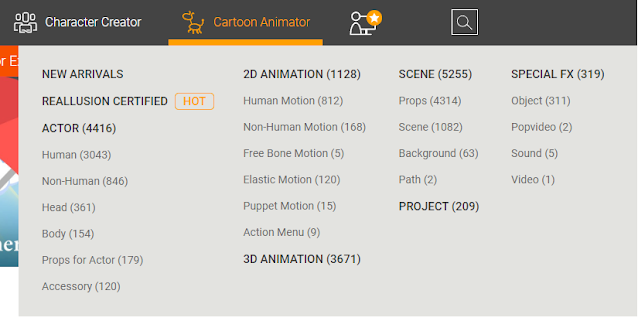2D Animation Side Hustle - Deciding What to Sell in the Reallusion 2D Marketplace, Your USP, and Keeping Customers Coming Back
If you missed part one on Starting Your Side Hustle and whether you can earn real money, or part two on Niches and how to find ones in demand, I highly recommend you read them for a more complete picture of selling in the Reallusion 2D Marketplace.
Deciding What To Sell
The Reallusion 2D Marketplace is divided into four broad categories; Actors, Scenes, Motions, and Special FX. Each of these are also divided into further sub categories. Interestingly in the Marketplace Menu it lists how many items are available for each category, making it easy to see which may be under served and could present an opportunity.
 |
| Reallusion 2D Marketplace Category Menu shows how many items are available in each category and could be a clue to what is being under served. |
While you could make content for all four categories, most developers tend to sell within either the Actor or Scene categories. Unless you have a specific interest in designing motion files or creating animated special effects, it's easier to start with either characters or scenes to begin with. Go with what you like creating the most.
Your Unique Selling Proposition (USP)
 |
| If you're in need of a Giraffe from the marketplace this is your top choices. Each one has a unique art style from realistic to cartoony, and even anthropomorphic. |
In the marketplace everyone is selling the same set of products e.g. characters, scene files etc. but what you have that no one else has is your unique creativity and art style. That means some part of a customer's decision to buy will come down to whether they like your art style.
Second to that is the niche you've chosen to create content around. The more competition you have in your niche the more a customer's decision will come down to what art style they like. (Though other factors may also come in to play like where your content shows up in search results).
Keep Customers Coming Back, Create a Series of Products
 |
| Content Developer, Azbuss, creates characters all in the same art style giving customers a reason to stay and select all their characters for a single production. |
Which doesn't mean you're going to be stuck creating one style of characters and scenes forever. You can design a whole new style of characters and scenes if you wish.
However you want to give your customers enough of each style to keep the artwork on their productions consistent. Nothing says amateur production more than a clash of art styles, where characters and backgrounds don't look like they belong together.
Despite that, don't think you have to start designing a series right away. Test the waters with one or two characters or scenes in the same art style and see if they sell. If you've found a high demand niche that is underserved then you should see sales. That's a great indicator to go ahead and make more in that style.
If you're not getting sales, you may need to get out into the Cartoon Animator Community and let people know you have these items for sale. You can even ask if people would be interested in seeing more in the series? If you're still not getting sales, it's possible your niche isn't in demand and it may be time to explore other niches.
Don't waste time and effort on a series that isn't selling.
In the next (and final) article on your 2D Animation Side Hustle I'll give an overview of how to upload, price, and package your content. As well I'll look at how to promote your content through SEO (Search Engine Optimization), offering Freebies, and outside the marketplace.
o---o--- ---o--- o---
Did you find this article useful?
Subscribe to my newsletter and get the
latest articles delivered to your inbox.


Comments
Post a Comment
This blog is monitored by a real human. Generic or unrelated spam comments with links to sites of dubious relativity may be DELETED.
I welcome, read, and respond to genuine comments relating to each post. If your comment isn't that save me some time by not posting it.